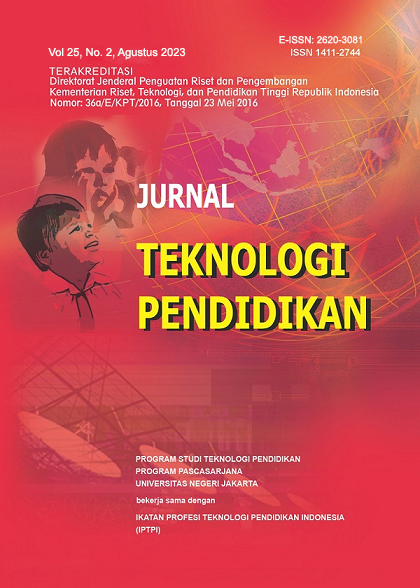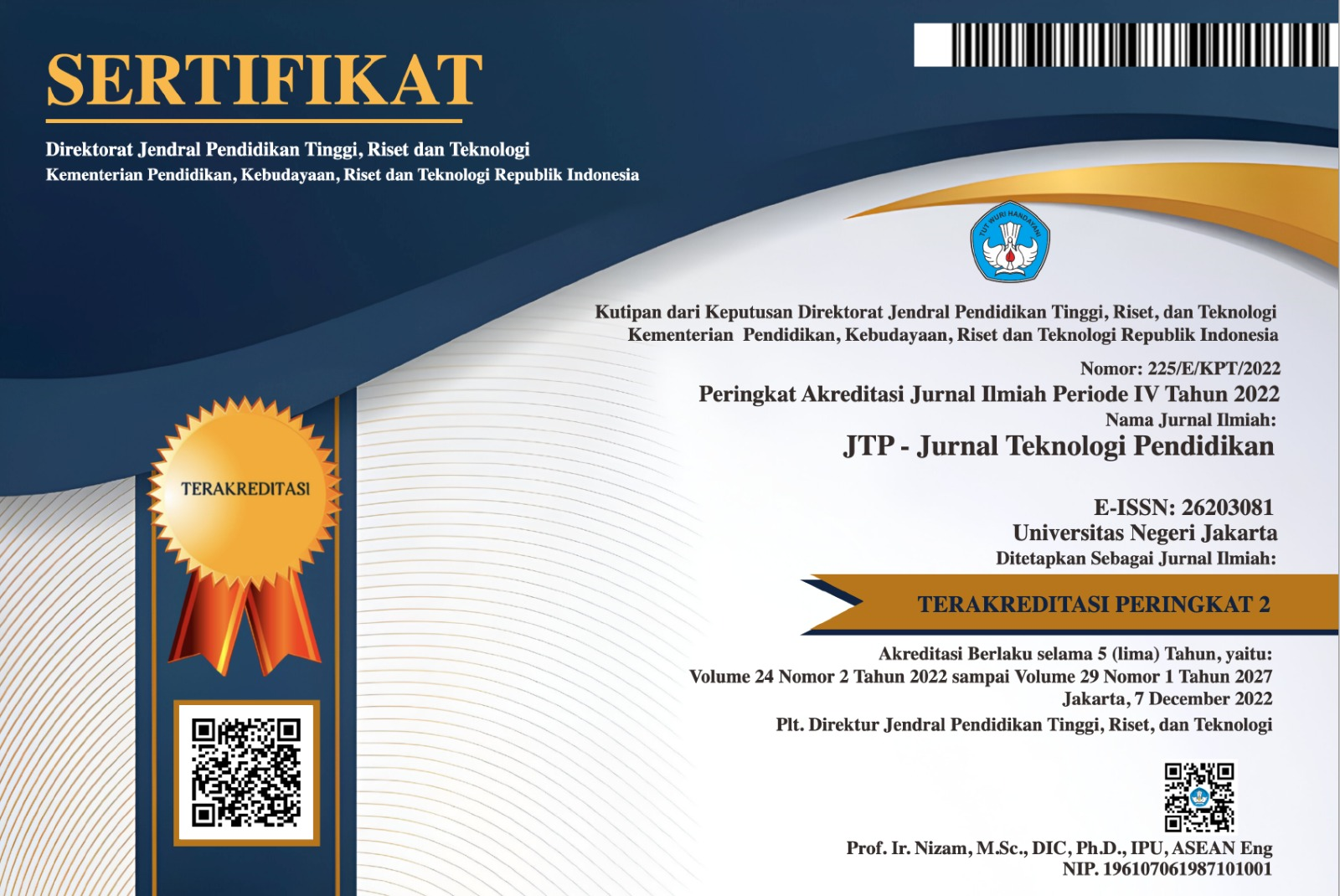Virtual Reality-Based Learning about "Animals Recognition" and Its Influence on Students' Understanding
DOI:
https://doi.org/10.21009/jtp.v25i2.36106Keywords:
virtual reality, learning media, animal recognition, ADDIEAbstract
The development of Educational technology has experienced a rapid increase which has consciously contributed positively to the motivation for learning achievement, as well as virtual reality media which can bring reality into learning activities. The aim of this research is to produce virtual reality media for learning to know animal’ diversity. This research type is Research and Development with the ADDIE’ developing model which consists 5 steps : 1. Analysis, 2. Design, 3. Development, 4. Impelmentation, 5. Evaluation. The research subject consists of media experts, material experts, teachers, and 27 elementary school second-grade students. Data collection techniques consist of tests and non-tests, with interview guidelines, questionnaires, and test instruments for data analysis tailored to each instrument using average, descriptive, and n-gain. Research results show that Virtual Reality products are declared suitable for use as learning media and are effective in increasing students' understanding of animal introduction for elementary school students. The results of assessments by media experts, material experts, and teachers also showed that these media belong to the category of "appropriate" to be used as learning media. In addition, the media is also included in the "effective" category to help students understand material about animal recognition based on n-gain analysis.
References
Abdillah, F., Riyana, C., & Alinawati, M. (2018). Pengaruh Penggunaan Virtual Reality Terhadap Kemampuan Siswa Pada Pembelajaran Ilmu Pengetahuan Alam Kelas VIII Sekolah Menengah Pertama. Edutcehnologia, 2(1), 36–37.
Al-Gindy, A., Felix, C., Ahmed, A., Matoug, A., & Alkhidir, M. (2020). Virtual reality: Development of an integrated learning environment for education. International Journal of Information and Education Technology, 10(3), 171–175. https://doi.org/10.18178/ijiet.2020.10.3.1358
Almadani, R., & Setiabudi, D. I. (2022). Pengembangan Kognitif Pada Siswa Sekolah Dasar Dengan Literatur Harian. Jurnal Riset Sosial Humaniora dan Pendidikan, 1(1), 34-42.
Ariatama, S., Adha, M. M., Rohman, Hartinio, A. T., & Ulpa, E. P. (2021). Penggunaan Teknologi Virtual Reality (VR) sebagai Upaya Eskalasi Minat dan Optimalisasi dalam Proses Pembelajaran Secara Online Dimasa Pandemik. Semnas FKIP, 2, 1–12. http://repository.lppm.unila.ac.id/32006/
Arikunto, S. (2010). Prosedur Penelitian Ilmiah. In Rineka cipta, Jakarta.
Asisdiq, I., Sudding, & Side, S. (2017). И Актуальная Проблема Здоровья Населения [ 1 , 2 , 12 ]. Он Оказывает Многосторонние Воздей - Ние Индивида И Даже На Продолжительность Жизни , Вовлекая Все Сферы Жизнедеятельности Человека И Откладывая Отпечаток На Возможности И Способы Взаимодействия Орг. Pendidikan Kimia PPs UNM, 1(1), 91–99.
Ayuni, N. W. D. (2022). Interactive Animation Learning Media on Android as a Creative Learning in Regression Analysis Topic. JTP - Jurnal Teknologi Pendidikan, 24(1), 9–22. https://doi.org/10.21009/jtp.v24i1.22567
Carter, M., Webber, S., Rawson, S., Smith, W., Purdam, J., & McLeod, E. M. (2020). Virtual reality in the zoo: A qualitative evaluation of a stereoscopic virtual reality video encounter with little penguins Eudyptula minor. Journal of Zoo and Aquarium Research, 8(4), 239–245. https://doi.org/10.19227/jzar.v8i4.500
Churches, A. 2007, Educational Origami, Bloom's and ICT Tools. http://www.techlearning.com/showArticle.php?articleID=196605124
Darojat, M. A., Ulfa, S., & Wedi, A. (2022). Pengembangan Virtual Reality Sebagai Media Pembelajaran Sistem Tata Surya. JKTP: Jurnal Kajian Teknologi Pendidikan, 5(1), 91–99. https://doi.org/10.17977/um038v5i12022p091
Dian, Rahadian. (2017). Teknologi Informasi Dan Komunikasi (TIK) Dan Kompetensi Teknologi Pembelajaran Untuk Pengajaran Yang Berkualitas. Jurnal Teknologi Pendidikan Dan Pembelajaran. 2(1), 234–54.
Fahmi, A. N., Yusuf, M., & Muchtarom, M. (2021). Integration of Technology in Learning Activities: E-Module on Islamic Religious Education Learning for Vocational High School Students. Journal of Education Technology, 5(2), 282–290. https://doi.org/10.23887/jet.v5i2.35313
Fitria, T. N. (2023). Augmented Reality (AR) and Virtual Reality (VR) Technology in Education: Media of Teaching and Learning: A Review. International Journal of Computer and Information System (IJCIS) Peer Reviewed-International Journal, 04(01), 2745–9659. https://ijcis.net/index.php/ijcis/indexJournalIJCIShomepage-https://ijcis.net/index.php/ijcis/index
Fitria, T. N. (2023). Augmented Reality (AR) and Virtual Reality (VR) Technology in Education: Media of Teaching and Learning: A Review. International Journal of Computer and Information System (IJCIS) Peer Reviewed-International Journal, 04(01), 2745–9659. https://ijcis.net/index.php/ijcis/indexJournalIJCIShomepage-https://ijcis.net/index.php/ijcis/index
Hake, R. R. (1999). Analyzing change/gain scores. Unpublished. https://www1.physics.indiana.edu/~sdi/AnalyzingChange-Gain.pdf
J. Martín-Gutiérrez, C. E. Mora, B. Añorbe-Díaz, and A. González-Marrero. (2017). Virtual Technologies Trends in Education,” EURASIA Journal of Mathematics, Science and Technology Education. 13(2), 469–486. doi: 10.12973/eurasia.2017.00626a.
Jang, J., Ko, Y., Shin, W. S., & Han, I. (2021). Augmented Reality and Virtual Reality for Learning: An Examination Using an Extended Technology Acceptance Model. IEEE Access, 9, 6798–6809. https://doi.org/10.1109/ACCESS.2020.3048708
Kamińska, D., Sapiński, T., Wiak, S., Tikk, T., Haamer, R. E., Avots, E., Helmi, A., Ozcinar, C., & Anbarjafari, G. (2019). Virtual reality and its applications in education: Survey. Information (Switzerland), 10(10). https://doi.org/10.3390/info10100318
M. Carter, S. Webber, S. Rawson, W. Smith, J. Purdam, and E. M. McLeod. (2020). Virtual reality in the zoo: A qualitative evaluation of a stereoscopic virtual reality video encounter with little penguins Eudyptula minor. J Zoo Aquar Res. 8(4), 239–245.
Maritsa, A., Salsabila, U. H., Wafiq, M., Anindya, P. R., & Ma’shum, M. A. (2021). Pengaruh Teknologi Dalam Dunia Pendidikan. Al-Mutharahah: Jurnal Penelitian Dan Kajian Sosial Keagamaan, 18(2), 91-100.
Mayorga, E., Novo, M., Fariña, F., & Seijo, D. (2020). Needs analysis for the personal, social, and psychological adjustment of adolescents at risk of delinquency and juvenile offenders. Anales de Psicologia, 36(3), 400–407. https://doi.org/10.6018/analesps.428631
Muhtarom, Herdin, and Dora Kurniasih. (2020). Pengaruh Model Pembelajaran Abad 21 Terhadap Pembelajaran Sejarah Eropa. BIHARI: JURNAL PENDIDIKAN SEJARAH DAN ILMU SEJARAH. 3(2).
Mulders, M., Buchner, J., & Kerres, M. (2020). A Framework for the Use of Immersive Virtual Reality in Learning Environments. International Journal of Emerging Technologies in Learning, 15(24), 208–224. https://doi.org/10.3991/ijet.v15i24.16615
Munawaroh, H., Fauziddin, M., Haryanto, S., Widiyani, A. E. Y., Nuri, S., El-Syam, R. S., & Hidayati, S. W. (2022). Pembelajaran Bahasa Daerah melalui Multimedia Interaktif pada Anak Usia Dini. Jurnal Obsesi : Jurnal Pendidikan Anak Usia Dini, 6(5), 4057–4066. https://doi.org/10.31004/obsesi.v6i5.1600
Musril, H. A., Jasmienti, J., & Hurrahman, M. (2020). Implementasi Teknologi Virtual Reality Pada Media Pembelajaran Perakitan Komputer. Jurnal Nasional Pendidikan Teknik Informatika (JANAPATI), 9(1), 83. https://doi.org/10.23887/janapati.v9i1.23215
N. Elmqaddem. (2019). Augmented Reality and Virtual Reality in Education. Myth or Reality?,” International Journal of Emerging Technologies in Learning (iJET). 14(03), 234. doi: 10.3991/ijet.v14i03.9289.
N. F. Saidin, N. D. Abd Halim, and N. Yahaya. (2015). A Review of Research on Augmented Reality in Education: Advantages and Applications. International Education Studies, 8(13), 1–8, Jun. doi: 10.5539/ies.v8n13p1.
Nichols Hess, A., & Greer, K. (2016). Designing for Engagement: Using the ADDIE Model to Integrate High-Impact Practices into an Online Information Literacy Course. Comminfolit, 10(2), 264. https://doi.org/10.15760/comminfolit.2016.10.2.27
Novitra, F., Festiyed, Yohandri, & Asrizal. (2021). Development of Online-based Inquiry Learning Model to Improve 21st-Century Skills of Physics Students in Senior High School. Eurasia Journal of Mathematics, Science and Technology Education, 17(9), 1–20. https://doi.org/10.29333/ejmste/11152
P. Albus, A. Vogt, and T. Seufert“. (2021). Signaling In Virtual Reality Influences Learning Outcome And Cognitive Load. Comput Educ. vol. 166. doi: 10.1016/j.compedu.2021.104154.
Perdana, M. A., Wibowo, D. E., & Budiarto, M. K. (2021). Digitalization of Learning Media through Digital Book Development Using the Flipbook Application. Jurnal Pendidikan Dan Pengajaran, 54(2), 263. https://doi.org/10.23887/jpp.v54i2.34639
Pramesti, A. A., Sitompul, R. P., & Sopiya, N. (2022). Systematic Literature Review: Pemanfaatan Virtual Reality (VR) Sebagai Alternatif Media Pembelajaran. Jurnal Pendidikan Teknologi dan Kejuruan, 19(2), 105-117
Rahadian, D. (2017). Teknologi informasi dan komunikasi (tik) dan kompetensi teknologi pembelajaran untuk pengajaran yang berkualitas. Teknologi Pembelajaran, 2(1).
Rahayu, R., Iskandar, S., & Abidin, Y. (2022). Inovasi pembelajaran abad 21 dan penerapannya di Indonesia. Jurnal Basicedu, 6(2), 2099-2104.
Rejekiningsih, T., Budiarto, M. K., & Sudiyanto, S. (2021). Pengembangan multimedia interaktif berbasis potensi lokal untuk pembelajaran prakarya dan kewirausahaan di SMA. Kwangsan: Jurnal Teknologi Pendidikan, 9(2), 167. https://doi.org/10.31800/jtp.kw.v9n2.p167--185
Rosidah, U. A., Marwoto, P., & Subali, B. (2021). Analysis of the Need for Android Based Mobile Learning Development to Improve Student Science Literations. Jurnal Penelitian Pendidikan IPA, 7(4), 601–606. https://app.dimensions.ai/details/publication/pub.1142792907%0Ahttps://jppipa.unram.ac.id/index.php/jppipa/article/download/805/pdf
S. F. M. Alfalah. (2018). Perceptions toward adopting virtual reality as a teaching aid in information technology. Educ Inf Technol (Dordr). 23(6), 2633–2653. doi: 10.1007/s10639-018-9734-2.
Salim, H. (2019). Penelitian Pendidikan : Metode, Pendekatan, dan Jenis. In Jakarta: Kencana.
Silalahi, A. (2018). Development Research (Penelitian Pengembangan) dan Research & Development (Penelitian & Pengembangan) dalam Bidang Pendidikan/Pembelajaran. Seminar & Workshop Penelitian Desertasi Program Doktoral Pasca Sarjana, June, 1–13.
Silalahi, U. (2015). Metode Penelitian Sosial Kuantitatif. Journal of Visual Languages & Computing, 11(3).
Styowati, E., & Utami, F. (2022). Pengembangan Video Pembelajaran Sains Berbasis Problem Based Learning. Jurnal Obsesi : Jurnal Pendidikan Anak Usia Dini, 6(4), 2472–2482. https://doi.org/10.31004/obsesi.v6i4.1970
Sugiyono. (2017). Metode Penelitian Pendidikan: Kuantitatif, Kualitatif, R&D. Bandung: Alfabeta.
Supriadi, M., & Hignasari, L. V. (2019). Pengembangan media pembelajaran berbasis virtual reality untuk meningkatkan hasil belajar peserta didik Sekolah Dasar. KOMIK (Konferensi Nasional Teknologi Informasi dan Komputer), 3(1).
Yung, R., & Khoo-Lattimore, C. (2019). New realities: a systematic literature review on virtual reality and augmented reality in tourism research. In Current Issues in Tourism (Vol. 22, Issue 17, pp. 2056–2081). https://doi.org/10.1080/13683500.2017.1417359
Z. Lugosi and P. C. Lee. (2021). A Case Study Exploring the Use of Virtual Reality in the Zoo Context. Anim Behav Cogn. 8(4), 576–588. doi: 10.26451/abc.08.04.09.2021.
Z. Lv, X. Li, and W. Li. (2017). Virtual reality geographical interactive scene semantics research for immersive geography learning. Neurocomputing, vol. 254, pp. 71–78, , doi: 10.1016/j.neucom.2016.07.078.
Zahabi, M., & Abdul Razak, A. M. (2020). Adaptive virtual reality-based training: a systematic literature review and framework. Virtual Reality, 24(4), 725–752. https://doi.org/10.1007/s10055-020-00434-w
Downloads
Published
How to Cite
Issue
Section
License
Jurnal Teknologi Pendidikan is an Open Access Journal. The authors who publish the manuscript in Jurnal Teknologi Pendidikan agree to the following terms.
Attribution-ShareAlike 4.0 International (CC BY-SA 4.0)
-
Attribution — You must give appropriate credit, provide a link to the license, and indicate if changes were made. You may do so in any reasonable manner, but not in any way that suggests the licensor endorses you or your use.
-
ShareAlike — If you remix, transform, or build upon the material, you must distribute your contributions under the same license as the original.
- No additional restrictions — You may not apply legal terms or technological measures that legally restrict others from doing anything the license permits.
Notices:
- You do not have to comply with the license for elements of the material in the public domain or where your use is permitted by an applicable exception or limitation.
- No warranties are given. The license may not give you all of the permissions necessary for your intended use. For example, other rights such as publicity, privacy, or moral rights may limit how you use the material.








